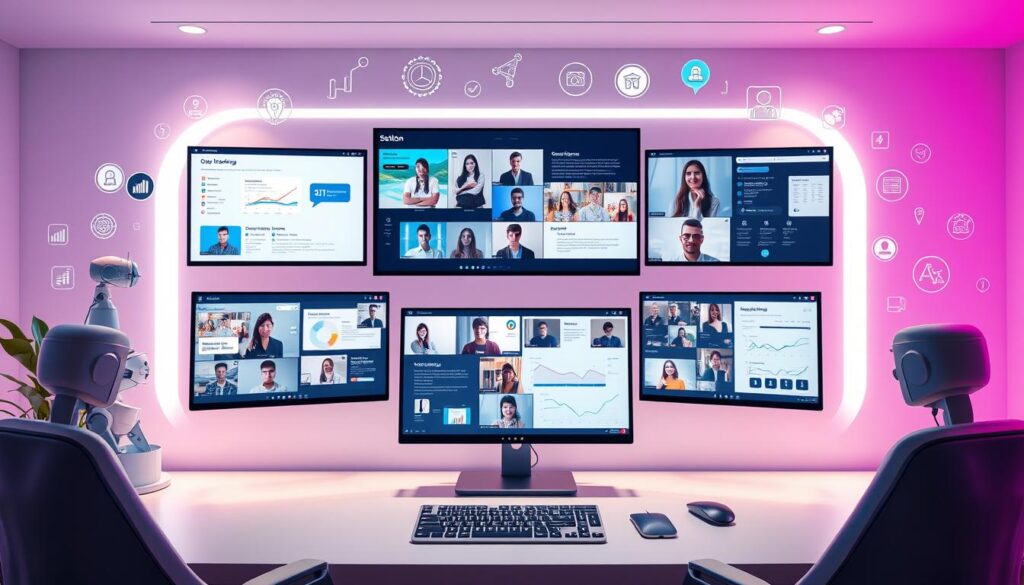In complex job market, getting candidates engaged is key to finding the best talent. By using the right strategies, companies can attract and keep top performers. This leads to better hiring results. This article will show you how to improve your candidate engagement and make the hiring process better for everyone.
Key Takeaways
- Effective communication is the foundation of successful candidate engagement
- Providing timely and transparent feedback improves the applicant experience
- Personalized outreach helps build stronger connections with candidates
- Streamlining the application process reduces friction and increases conversions
- Leveraging technology can enhance the overall candidate engagement process
Effective Communication: The Key to Successful Candidate Engagement
Keeping applicant communication clear and consistent is key. It builds trust and creates a positive candidate experience. Giving timely and clear feedback, and reaching out personally, boosts candidate engagement and happiness.
Timely and Transparent Feedback
Candidates want to know what’s happening with their application. Quick feedback, whether it’s a no or a yes, shows respect. It keeps their hopes up and makes them feel valued, even if they don’t get the job.
Personalized Outreach
Using generic emails is not enough. A personal touch in outreach stands out. Tailoring messages to each candidate’s skills and interests shows you care. This makes a big difference in the candidate experience and builds a stronger connection.
Effective communication in the onboarding process helps your reputation. It creates a pool of happy, engaged candidates, even if they’re not hired.
Building a Positive Candidate Experience
In job market, making a good impression on candidates is key. Companies that focus on the candidate’s journey can show off their employer brand. This helps build long-term relationships and boosts talent acquisition.
Having a positive candidate experience is crucial. A study by Talent Board showed that happy candidates are 38% more likely to say yes to a job. They are also 82% more likely to come back.
To create a great candidate experience, focus on these areas:
- Make the application process easy and quick
- Give clear job descriptions to set the right expectations
- Offer feedback that’s on time and personal
- Be friendly and welcoming to all candidates
By focusing on the candidate experience, companies can attract better talent. This also improves their employer branding and reputation. A strong reputation leads to more qualified candidates and a smoother talent acquisition process.
| Key Aspects of Positive Candidate Experience | Benefits for Organizations |
|---|---|
| Streamlined application process | More people apply, and you get a bigger pool of good candidates |
| Clear and transparent job descriptions | You get candidates who are a better fit, and they’re less likely to leave early |
| Timely and personalized feedback | Candidates are happier, and your brand looks better |
| Positive and welcoming interactions | Your employer brand gets stronger, and you get more referrals and reapplications |
By always providing a positive candidate experience, companies can attract the best talent. They also build a strong employer brand that stands out in the job market.
Candidate engagement best practices
It’s key to engage candidates well to make the hiring process better. By making the application easy and clear, companies can attract the best people. This makes the job search experience good for everyone.
Streamlining the Application Process
Making the application process simple is a top tip. This means fewer steps, less info needed, and an easy-to-use system. It keeps candidates interested and makes them more likely to apply.
Providing Clear Job Descriptions
Writing clear job descriptions is also vital. They should list what the job is, what you need to do it, and what you need to have done it. This helps candidates decide if they’re a good fit. It also makes the hiring process smoother.
| Best Practices for Streamlining the Application Process | Best Practices for Providing Clear Job Descriptions |
|---|---|
| Reduce the number of required steps Minimize the amount of information requested Optimize the application interface for mobile devices Offer multiple application options (e.g., resume upload, online application) Provide clear instructions and guidance throughout the process | Clearly define the roles and responsibilities of the position Outline the required qualifications, skills, and experience Highlight the key job duties and day-to-day tasks Provide information about the company, culture, and benefits Ensure the job description is comprehensive yet concise |
Using these tips can make the hiring process better. It leads to better hires and a stronger team.
Leveraging Technology for Enhanced Engagement
In the world of recruitment, technology has changed the game. New tools and strategies have made it easier for employers to connect with candidates. This has made the hiring process smoother and more engaging for job seekers.
Applicant Tracking Systems
Applicant tracking systems (ATS) are a big help in finding the right candidates. They help organize job applications and track candidates. This lets recruiters spend more time on important hiring tasks.
Virtual Recruitment Tools
Virtual tools have changed how employers meet candidates. They include virtual job fairs, video interviews, and online tests. These tools help reach more talent and make the hiring process more engaging.

“Embracing technology has become a game-changer in the world of recruitment, allowing employers to streamline the hiring process and deliver a more engaging experience for job seekers.”
Using virtual recruitment tools and ATS has improved how employers engage with candidates. Technology helps create a better candidate experience. This leads to better hiring results for organizations.
Developing a Strong Employer Brand
In complex market, having a strong employer brand is key for companies to attract and keep the best talent acquisition. By showing off their unique company culture, values, and employee experiences, companies stand out. This makes them more appealing to job seekers.
To build a strong employer brand, companies need to do more than just post job ads. They must understand their own identity, strengths, and what attracts the right talent. Sharing real stories from current employees helps paint a clear picture of working there. This creates excitement and a sense of belonging for those looking to join.
Effective employer branding strategies include:
- Sharing the company’s mission, values, and purpose to match what job seekers want
- Showing off unique benefits, perks, and growth chances for employees
- Using employee stories and social media to share real views of the workplace
- Creating a strong and consistent brand image in all recruitment materials
- Building a positive and welcoming company culture that shows in the employee experience
Investing in a solid employer branding strategy helps companies not only find but also keep the best talent. This leads to a happier and more loyal workforce. It also boosts talent acquisition and helps the company succeed in the long run.
“A strong employer brand is not just about attracting new talent – it’s about retaining your best people and fostering a culture of engagement and loyalty.”
Cultivating a Talent Pipeline
In today’s fast-changing world of talent acquisition, it’s key to build a talent pipeline. This means always talking to potential candidates and making strong connections. This way, you can have a group of skilled people ready to join your team. They can help keep your employee retention and company culture strong.
Networking and Referrals
Using networking and referrals is a smart move for a strong talent pipeline. Get your team involved in industry events and conferences. It helps build a community and gives chances to meet people who might be great for your team.
Also, offer rewards for your team to bring in good candidates from their networks. Referrals often lead to better hires and quicker starts.
Social Media Presence
In today’s digital world, having a strong social media presence is crucial for talent acquisition. Be active on sites like LinkedIn, Twitter, and Instagram. Show off your company’s culture, values, and job openings.
Post interesting content, join in on discussions, and use ads to reach more people. A strong online image can draw in the best talent. It also helps create a company culture that attracts the right people.
“Building a talent pipeline is an ongoing effort, not just a one-time thing. By focusing on these strategies, companies can keep a steady flow of skilled candidates. This boosts employee retention and leads to lasting success.”
Onboarding: The Final Step in Candidate Engagement
The onboarding process is key in the candidate journey. It makes new hires feel welcome and valued. This helps them stay and grow with the company, building a strong culture.
Good onboarding is more than just paperwork. It’s about teaching the company’s vision and giving tools for success. This helps new employees thrive in their roles.
Cultivating a Positive Onboarding Experience
To make onboarding great, follow these tips:
- Give a warm welcome and introduce the team and culture.
- Have a mentor to help with the transition.
- Provide training to build skills and knowledge.
- Keep lines of communication open for feedback.
- Celebrate achievements to show appreciation.
Investing in a strong onboarding process boosts retention. It creates a loyal and engaged team that fits the company’s culture.
| Onboarding Best Practices | Benefits |
|---|---|
| Personalized Onboarding | Helps new hires feel valued and integrated |
| Comprehensive Training | Equips new employees with necessary skills and knowledge |
| Open Communication | Addresses concerns and fosters a supportive environment |
| Celebration of Milestones | Reinforces a sense of belonging and appreciation |
Using these onboarding tips ensures a smooth start for new hires. This leads to better retention and a more united company culture.
Measuring and Improving Recruitment Strategies
Measuring and analyzing recruitment metrics and data can change the game for organizations. It helps them improve their candidate engagement efforts. Employers can make better decisions and enhance the hiring experience by using data insights.
Data Analysis and Metrics
Dive deep into your recruitment data to uncover valuable insights. Track key performance indicators (KPIs) such as application-to-hire ratio, time-to-fill, and employee retention rates. Use this information to identify areas for improvement and make data-backed decisions to enhance your recruitment strategies.
| Metric | Description | Importance |
|---|---|---|
| Application-to-Hire Ratio | The number of applications received compared to the number of successful hires. | Helps evaluate the effectiveness of your job postings and sourcing channels. |
| Time-to-Fill | The average time it takes to fill a vacant position. | Identifies bottlenecks in the recruitment process and opportunities to streamline. |
| Employee Retention Rate | The percentage of employees who remain with the organization over a given period. | Provides insights into the quality of candidate engagement and your onboarding program. |
By continuously monitoring and analyzing these metrics, you can make data-driven adjustments to your recruitment strategies. This helps you attract, engage, and retain top talent.
“Successful recruitment is not just about filling vacancies – it’s about building a strong, engaged workforce that drives business growth.”
The key to improving your recruitment efforts is understanding the data. Use it to inform your decisions. Stay agile, adaptable, and committed to continuously refining your recruitment strategies for long-term success.

Fostering a Culture of Continuous Improvement
Creating a company culture that values continuous improvement is crucial. It helps keep successful candidate engagement practices alive. By listening to employee feedback, empowering teams, and adapting to market changes, companies can stay ahead.
A culture that values learning and adaptability is essential. Asking for feedback from all employees helps improve the talent acquisition process. It also boosts employee retention. Letting teams try new recruitment methods and tools can lead to real progress.
In today’s fast-changing business world, being quick to adapt is key. A continuous improvement mindset helps companies stay flexible. It allows them to refine their candidate engagement and keep a strong edge in the talent market.
Frequently Asked Questions
Kuldeep Nirgude is a computer science student with a strong interest in finance and marketing. With a focus on analyzing industry trends, he writes articles that simplify complex concepts and empower readers to make informed decisions. Kuldeep is dedicated to bridging the gap between technology and business, and is committed to staying updated on the latest innovations shaping the economy.
